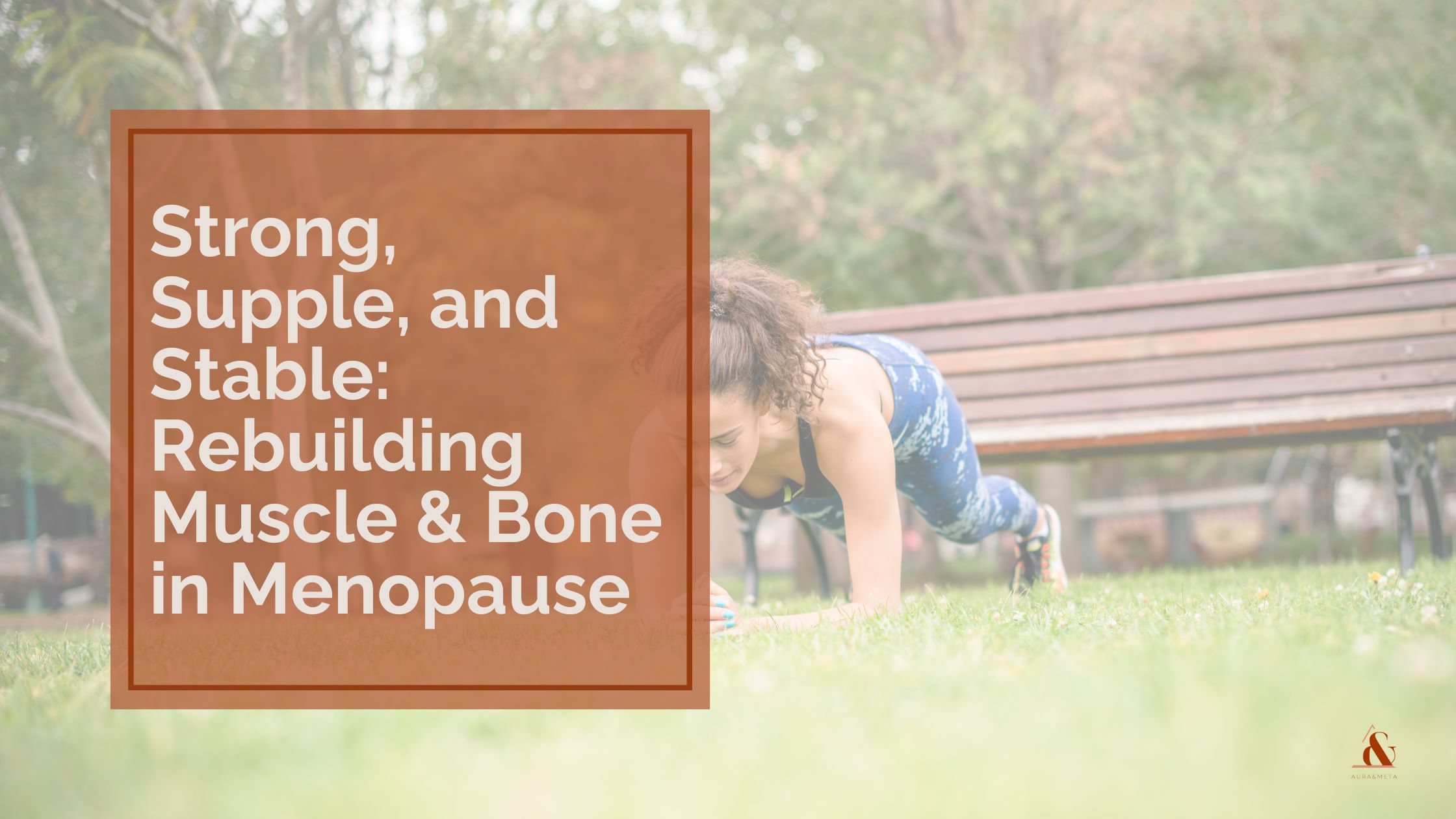Why Loss of Lean Tissue Is Common and Reversible
Many women in perimenopause and menopause notice subtle but telling changes: struggling to carry shopping bags, slower recovery after workouts, or nagging stiffness in the joints. These shifts are not simply “getting older”, they reflect hormonal transitions that directly affect how our bodies build and maintain lean muscle and strong bone.
The empowering truth? Decline is not inevitable. With the right nutrition, movement, and energetic alignment, women can rebuild strength, stability, and vitality. At Aura & Meta, we guide women to restore balance on all levels – physical, emotional, and energetic – so the body feels strong, supple, and stable again.
How Oestrogen & Progesterone Affect Muscle & Bone Health in Menopause
Hormones are not just messengers for reproduction, they are architects of resilience. Oestrogen helps regulate bone turnover, balancing bone-building osteoblasts and bone-resorbing osteoclasts. As levels fall, bones may become thinner and more porous, increasing the risk of osteopenia or osteoporosis.
Progesterone supports tissue repair, muscle recovery, and joint integrity. Declines can mean slower healing from micro-injuries, contributing to stiffness or reduced exercise tolerance.
The combined drop explains why midlife women face higher risks of fractures, posture changes, and sarcopenia but awareness allows us to intervene proactively.
Early Signs Your Foundation Needs Rebuilding
Even before a diagnosis, your body whispers:
– Persistent aches or stiffness
– Reduced grip strength or difficulty lifting
– Subtle posture changes or balance issues
– Slower recovery after activity or more frequent injuries
These are invitations to act early and rebuild resilience.
Nutrition for Bone Density & Muscle Strength in Menopause
At midlife, nutrition must move from maintenance to rebuilding. Foundational supports include:
– Protein: Essential for muscle synthesis and repair. Include beans, lentils, poultry, eggs, fish and distribute protein evenly across meals.
– Calcium: Leafy greens, almonds, sesame seeds, and sardines nourish bone density without relying solely on dairy.
– Vitamin D: Critical for calcium absorption and immune health. Deficiency is common in midlife and directly impacts fracture risk.
– Magnesium: Helps muscles contract and relax, while supporting bone structure and energy metabolism.
– Collagen: Provides peptides for connective tissue, skin, and joint integrity.
Functional medicine also emphasises oestrogen metabolism: cruciferous vegetables, flax, green tea, and resveratrol-rich foods help the body process oestrogen down safer pathways, protecting bones, muscles, and tissues.
Learn more in our related blog: Beyond the Liver: Hidden Toxins That Disrupt Midlife Hormones
Want help building a personalised midlife nutrition plan? Book your free discovery call to map your next steps.
Best Exercises for Rebuilding Muscle & Bone in Menopause
To rebuild, the type of exercise matters more than the duration:
– Resistance training: Weights, resistance bands, or bodyweight exercises build lean tissue and stimulate bone growth.
– Load-bearing impact: Walking, stair climbing, or light jogging strengthen bones through gentle stress.
– Mobility & balance: Yoga, Pilates, or tai chi prevent stiffness, improve posture, and reduce fall risk.
Kinesiology & Energy Alignment for Posture & Stability
True resilience is not only mechanical but also energetic. Kinesiology can:
– Identify hidden muscular imbalances that lead to poor posture or compensation.
– Release stored stress patterns that hinder recovery.
– Align energy systems so the body feels both stable and fluid.
When muscles, bones, and energy flow align, women often rediscover not only strength but also confidence and presence.
From Depletion to Empowerment
Menopause does not mean decline. It can be a season of renewal, an opportunity to build a stronger foundation than ever before. Through nutrient-rich food, movement medicine, and energy alignment, you can cultivate supple muscles, strong bones, and deep stability.
“Menopause is not decline, it’s a design for renewal.”
Read more here: Immunity and the Second Spring: Protecting Vitality in Midlife
Explore more insights on midlife strength and hormone balance at the Aura & Meta Blog
Frequently Asked Questions
Can I rebuild muscle after menopause?
Yes. With adequate protein, resistance training, and hormonal balance, muscle tissue can be rebuilt even after menopause.
What is the best exercise for bone density in menopause?
Resistance and load-bearing training (weights, walking, stair climbing) are proven to stimulate bone formation and reduce fracture risk.
How does kinesiology help in menopause?
It improves posture, releases stress-related tension, and aligns energy pathways that support muscular recovery and balance.
Join The Empowered Reset – Winter Edition
Our upcoming 7-Day Empowered Reset (Winter Edition) starts on 12 January 2026: a restorative, food-first programme designed to rebalance hormones and rebuild energy for the new year.
Book your place today and step into the new season feeling strong, supple, and stable.

